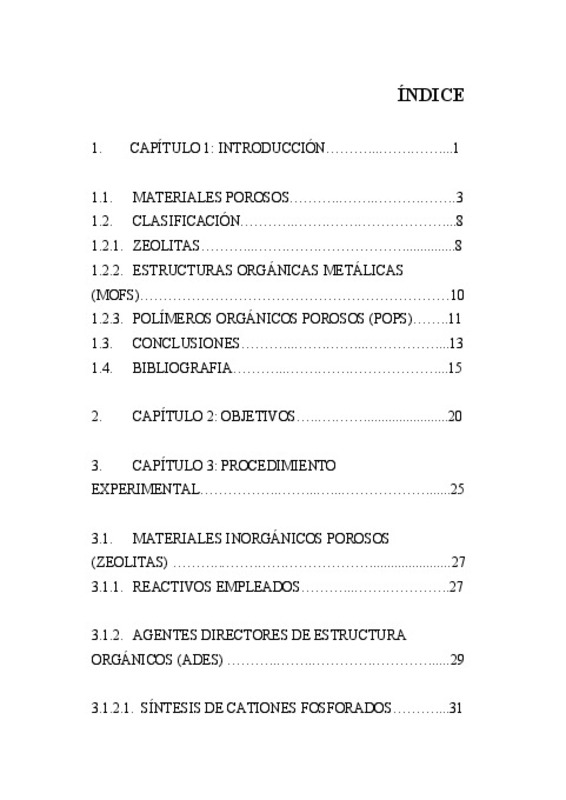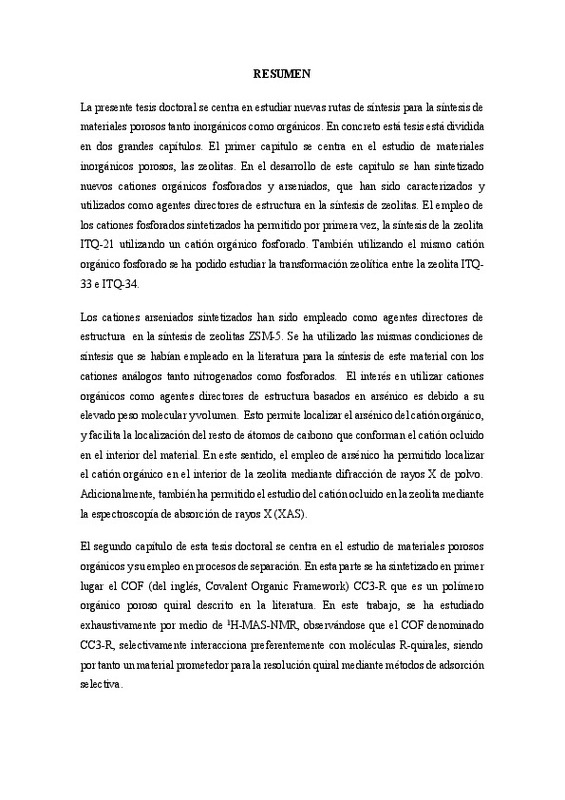|
Resumen:
|
[ES] La presente tesis doctoral se centra en estudiar nuevas rutas de síntesis para la síntesis de materiales porosos tanto inorgánicos como orgánicos. En concreto está tesis está dividida en dos grandes capítulos. El ...[+]
[ES] La presente tesis doctoral se centra en estudiar nuevas rutas de síntesis para la síntesis de materiales porosos tanto inorgánicos como orgánicos. En concreto está tesis está dividida en dos grandes capítulos. El primer capitulo se centra en el estudio de materiales inorgánicos porosos, las zeolitas. En el desarrollo de este capitulo se han sintetizado nuevos cationes orgánicos fosforados y arseniados, que han sido caracterizados y utilizados como agentes directores de estructura en la síntesis de zeolitas. El empleo de los cationes fosforados sintetizados ha permitido por primera vez, la síntesis de la zeolita ITQ-21 utilizando un catión orgánico fosforado. También utilizando el mismo catión orgánico fosforado se ha podido estudiar la transformación zeolítica entre la zeolita ITQ-33 e ITQ-34.
Los cationes arseniados sintetizados han sido empleado como agentes directores de estructura en la síntesis de zeolitas ZSM-5. Se ha utilizado las mismas condiciones de síntesis que se habían empleado en la literatura para la síntesis de este material con los cationes análogos tanto nitrogenados como fosforados. El interés en utilizar cationes orgánicos como agentes directores de estructura basados en arsénico es debido a su elevado peso molecular y volumen. Esto permite localizar el arsénico del catión orgánico, y facilita la localización del resto de átomos de carbono que conforman el catión ocluido en el interior del material. En este sentido, el empleo de arsénico ha permitido localizar el catión orgánico en el interior de la zeolita mediante difracción de rayos X de polvo. Adicionalmente, también ha permitido el estudio del catión ocluido en la zeolita mediante la espectroscopía de absorción de rayos X (XAS).
El segundo capítulo de esta tesis doctoral se centra en el estudio de materiales porosos orgánicos y su empleo en procesos de separación. En esta parte se ha sintetizado en primer lugar el COF (del inglés, Covalent Organic Framework) CC3-R que es un polímero orgánico poroso quiral descrito en la literatura. En este trabajo, se ha estudiado exhaustivamente por medio de 1H-MAS-NMR, observándose que el COF denominado CC3-R, selectivamente interacciona preferentemente con moléculas R-quirales, siendo por tanto un material prometedor para la resolución quiral mediante métodos de adsorción selectiva.
[-]
[CA] La present tesi doctoral se centra a estudiar noves rutes de síntesis de materials porosos tant inorgànics com orgànics. En concret, aquesta tesi esta dividida en dos grans capítols. El primer capítol se centra en ...[+]
[CA] La present tesi doctoral se centra a estudiar noves rutes de síntesis de materials porosos tant inorgànics com orgànics. En concret, aquesta tesi esta dividida en dos grans capítols. El primer capítol se centra en l'estudi de materials inorgànics porosos, les zeolites. En el desenvolupament d'aquest capítol s'han sintetitzat nous cations orgànics fosforats i arsenats, que han sigut caracteritzats i utilitzats com agents directors d'estructura en la síntesi de zeolites. L'ús de cations fosforats sintetitzats ha permés per primera vegada, la síntesi de la zeolita ITQ-21 utilitzant un catió orgànic fosforat. També utilitzant el mateix catió orgànic fosforat s'ha pogut estudiar la transformació zeolítica entre la zeolita ITQ-33 i ITQ-34.
Els cations arsenats sintetitzats han sigut utilitzats com agents directors d'estructura en la síntesi de la zeolita ZSM-5. S'hi ha empleat les mateixes condicions de síntesis que s'havien utilitzat en la literatura per a la síntesi d'aquest material amb els cations anàlegs tant nitrogenats com fosforats. L'interés a utilitzar cations orgànics com agents d'estructura basats en arsènic és a causa del seu elevat pes molecular i volum. Açò permet localitzar l'arsènic del catió orgànic i facilita la localització de la resta d'àtoms de carboni que conformen el catió oclòs a l'interior del material. En aquest sentit, l'ús d'arsènic hi ha permés localitzar el catió orgànic en l'interior de la zeolita mitjançant la difracció de raig X de pols. Addicionalment, també hi ha permés l'estudi del catió oclòs a la zeolita mitjançant l'espectroscòpia d'absorció de raig X (XAS).
El segon capítol d'aquesta tesi doctoral se centra en l'estudi de materials porosos orgànics i el seu ús en processos de separació. En aquesta part s'ha sintetitzat en primer lloc el COF ( de l'anglès, Covalent Organic Frameworks) CC3-R que és un polímer orgànic porós quiral descrit a la literatura. En aquest treball, s'ha estudiat exhaustivament per mitjà de 1H-MAS-NMR, observant-se que el COF denominat CC3-R, selectivament interacciona preferentment amb molècules R-quirals, sent per tant un material prometedor per a la resolució quiral mitjançant mètodes d'adsorció selectiva.
[-]
[EN] The present doctoral thesis focuses on studying new synthesis routes for the synthesis of porous materials, both inorganic and organic. In particular, this thesis is divided into two major chapters. The first chapter ...[+]
[EN] The present doctoral thesis focuses on studying new synthesis routes for the synthesis of porous materials, both inorganic and organic. In particular, this thesis is divided into two major chapters. The first chapter focuses on the study of porous inorganic materials, zeolites. In the development of this chapter, new organophosphate and phosphorous organic cations have been synthesized, which have been characterized and used as structure directing agents in the synthesis of zeolites. The use of synthesized phosphorated cations has allowed, for the first time, the synthesis of the ITQ-21 zeolite using a phosphorous organic cation. Also using the same organic phosphorus cation, it has been possible to study the zeolitic transformation between ITQ-33 and ITQ-34 zeolite.
Synthesized arsenized cations have been used as structure directing agents in the synthesis of ZSM-5 zeolites. The same synthesis conditions that had been used in the literature for the synthesis of this material with the analogous cations both nitrogen and phosphorus have been used. The interest in using organic cations as structure directing agents based on arsenic is due to its high molecular weight and volume. This allows locating both the arsenic of the organic cation and the location of the remaining carbon atoms that make up the cation occluded inside the material. In this sense, the use of arsenic has made it possible to locate the organic cation inside the zeolite by powder X-ray diffraction. Additionally, it has also allowed the study of the occluded cation in zeolite by X-ray absorption spectroscopy (XAS).
The second chapter of this doctoral thesis focuses on the study of organic porous materials and their use in separation processes. In this part, the COF (Covalent Organic Framework) CC3-R, which is a chiral porous organic polymer described in the literature, has been synthesized in the first place. In this work, it has been studied exhaustively by means of 1H-MAS-NMR, observing that the COF denominated CC3-R, selectively interacts preferably with R-chiral molecules, being, therefore, a promising material for the chiral resolution by means of selective adsorption methods.
[-]
|











